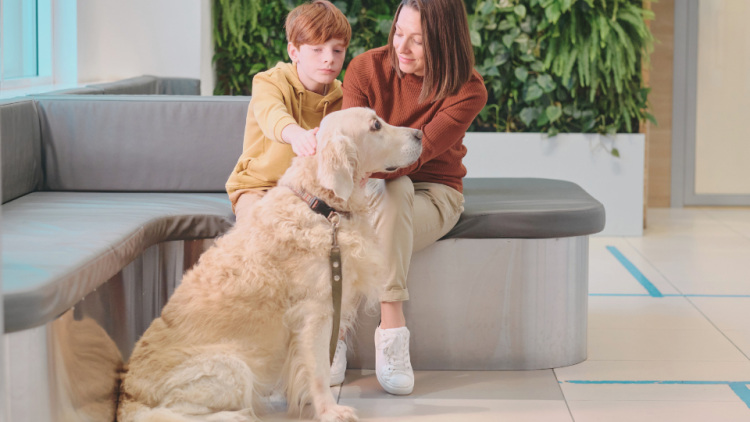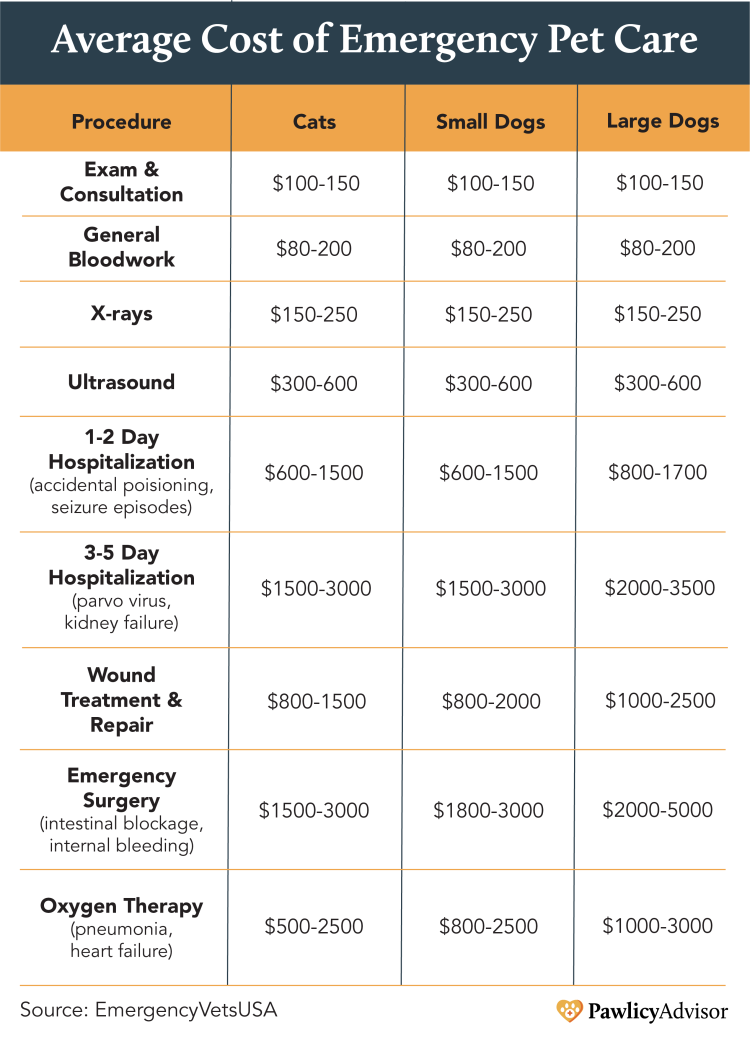If your pet is sick or injured, you will want to seek veterinary care. The question is, where? Do you wait for your regular veterinarian to open after the night, weekend, or holiday or do you take your pet to a local emergency veterinarian? The answer will vary depending on how serious your pet’s illness or injury is.
Learning to recognize signs of a severe or life-threatening disease process in your pet can help you make the best possible decision on where to seek care and how to make the veterinary visit go as smoothly as possible.
Pet Emergencies in a Post-Pandemic World
With the large increase in pet ownership during the pandemic, veterinary hospitals are overwhelmed at all levels. Some general practice clinics are not accepting new clients, and many are booking several weeks out, even for sick pets. The overflow of patients with chronic or minor problems has ended up at pet emergency rooms seeking care.
This increased patient load compounded the problems presented by altered workflows in veterinary hospitals due to Covid-19 safety protocols and difficulty staffing emergency veterinarians and technicians. Wait times in pet emergency rooms have increased to extraordinary lengths, sometimes 12 hours or more.
Some clinics have been forced to reduce emergency hours or temporarily close their services altogether. These changes have been necessary to protect the mental health of the staff in a profession where suicide rates are more than double that of the general population, but many pet owners are left in an even harder position to find care.
One thing you can do as a pet owner to help the situation is make sure that you are only taking your pet to an emergency room for serious illness or injury. If your pet has a less critical condition, wait until your regular veterinarian can see your pet, even though the hours may not be as convenient. Do you really want to sit in the parking lot or waiting room of your local pet ER for 12 hours waiting to receive an assessment and treatment of an ear infection?
However, it can be hard to tell minor symptoms apart from those that may indicate a life-threatening emergency. Many owners consider pets as people and want to ensure their loved ones receive the essential health care they need to alleviate suffering as fast as possible. While your vet’s opinion will always be the best source of information, here are some guidelines on when you should seek emergency pet care.

What Are Medical Emergencies in Pets?
Some emergencies are obvious and warrant immediate or urgent care. Other emergencies can have more subtle clinical signs. If your pet is experiencing any of the following, contact a veterinarian immediately:
- Trauma, including being hit by a vehicle, dog fights and bite wounds, falling from a large height, or gunshot wounds. Any pet who has experienced a trauma should be evaluated for both external and internal injuries.
- Bleeding Wounds, especially deep lacerations or cuts that won’t stop bleeding, should be addressed urgently. You can apply pressure to the wound while you transport your pet to the veterinary office. Keeping a Pet First Aid Kit handy can help in situations like this until you can seek veterinary care.
- Injuries, such as burns, sloughing of skin, obvious fractured limbs, and wounds to the eye.
- Toxin Ingestion is often a serious emergency. Common toxins can include chocolate or other human foods, human or pet medications, rat poison, and xylitol (a sugar substitute found in some chewing gum and other human foods and medications). If your pet ingests something that you think may be toxic, call the Pet Poison Helpline or ASPCA Poison Control. These services charge a small fee but will let you know if your pet is at risk for poisoning from what they ingested and how to proceed.
- Difficulty Breathing, especially if your pet has a history of respiratory disease, a heart murmur, or other heart condition.
- Pets Who Are Non-Responsive or becoming less responsive over time.
- Collapse Episodes, especially if your pet is non-responsive during the episode.
- Seizure Activity. Pets that have experienced a first-time seizure, especially if it lasts more than 1-2 minutes, have had more than 2 seizures in a 24 hour period, or have been seizuring continuously for more than 5 minutes, are considered an emergency. Pets with a known seizure history and those on medication for seizures should discuss with their veterinarian when to seek emergency care.
- Dystocia, or trouble giving birth to puppies or kittens. In general, if your pet is in labor and actively pushing for more than 30 minutes without producing a puppy or kitten, they should be evaluated. Additionally, if you know that your dog or cat has not birthed the entire litter and it has been more than 4 hours with no attempts to push, contact your veterinarian.
- Severe Allergic Reactions or Anaphylactic Shock, which usually will present with facial swelling, hives, and may include difficulty breathing and collapse.
- Inability to Urinate, a possible indication of urinary obstruction.
- Attempting to Vomit and Only Retching, which can be a sign of bloat (Gastric Dilatation and Volvulus, or GDV).
- Acute, Profuse Vomiting and/or Diarrhea, especially if your pet is becoming lethargic, unable to keep water down, vomits blood, or has diarrhea that is straight blood or is dark and tarry. Puppies who have not finished their vaccine series who develop vomiting and diarrhea should be evaluated for parvovirus.
- Sudden Blindness or changes in your pet’s vision
- Changes in Eye Appearance, including a change in the color on the surface of the eye or protrusion of the eye.
- Inability to Use Legs or dragging limbs.

Non-Emergency Health Conditions in Pets
There are many illnesses or conditions that your pet might develop that need veterinary care but do not require a same-day emergency visit. If you notice the following symptoms, call your veterinarian to schedule a visit, but don’t rush off to the emergency room:
- Skin Conditions, including itchy skin, chewing at paws, hair loss, odor, and crusting/scabbing.
- Ear infections, indicating by itching at ears, odor or debris in ears, and sometimes swelling of the ear pinna (the flap of the ear).
- Urinary Accidents
- Lumps and Bumps
- Weight-Bearing Lameness, which means your pet is limping but still able to walk on all four limbs.
- Weight Loss.
- Occasional Vomiting or Diarrhea, especially if your pet is still interested in food, able to keep water down, and is otherwise acting normal.
- Coughing without Difficulty Breathing.
- Broken Teeth that do not impede your pet’s ability to close their mouth or interfere with eating.
In many of these cases, your pet may seem uncomfortable, but do not give any over-the-counter medications without first speaking with your veterinarian. Please note that in most states, veterinarians who have not examined your pet within the past year cannot prescribe or recommend medication and treatment without an examination.
Who to Call For a Pet Emergency
It’s always best to call your veterinarian for advice when you are in doubt. If you’re out of the area or their office hours are closed, do a search for “emergency vet near me” to find a local 24 hour vet who can help.
Be prepared to answer questions about your pet’s behavior, appetite, urination and defecation, breathing, gum color, and concurrent diseases or current medications. Veterinary teams are trained to ask these questions to help them make the best possible recommendation on when and where to seek care. Remember that the Pet Poison Helpline and ASPCA Poison Control are valuable resources to call during a pet emergency caused by a toxic substance.
If you are heading to an emergency pet hospital or vet clinic without an appointment, take a few minutes to call ahead and let the staff know you are coming. This allows the veterinary team to prepare for your pet’s arrival in an urgent situation and for you to be advised of any safety protocols and possible wait times. In some cases, depending on the current caseload, you may be directed to a different animal emergency center.

What to Expect at Emergency Pet Hospitals
Once at the emergency pet hospital or vet clinic, your pet will be assessed shortly after arrival. If they are deemed stable, you will likely be in for a bit of a wait. While this can be frustrating, you must trust the veterinary team to do what is best. They must prioritize the most critical patients. Waiting in the cat or dog ER means your pet is stable and will likely be coming home with you. Unfortunately, other families will not be as lucky.
Please be patient and kind to the clinic staff, from the front desk staff to the technicians and veterinarians, as they are under immense stress. With pet owners and veterinary teams working together, we can ensure the best outcomes for as many pets and families as possible.
How Much Does an Emergency Vet Visit Cost?
There are many different procedures that your pet might need at an animal hospital to treat a severe injury or illness, ranging from a few hundred to a few thousand dollars in price. For example, the average cost of emergency vet care that requires hospitalization for 3-5 days is $1,500-3,000, while surgery in the pet ER can cost up to $5,000.

Although prices vary depending on the size of your animal, where you live, and the time of treatment, many pet parents find it difficult to afford unexpected emergency vet bills, leaving them under financial stress during an already stressful situation. In these circumstances, pet insurance can provide valuable peace of mind by reimbursing up to 100% of covered vet visit costs paid for out of pocket (once the policy deductible is met). This ensures pets have access to gold-standard care while reducing the financial burden on owners and enabling them to focus on their loved ones, rather than the cost of care in a cat or dog ER.
Pet wellness plans can also cover routine exams in which your veterinarian will screen for possible health conditions. Early detection of disease can help prevent a severe manifestation of symptoms that could cause a life-threatening emergency if left undetected. Together, you and your vet can create a healthcare plan that manages the clinical signs of illness, promotes optimal health, and helps you avoid sudden pet emergencies through proactive care.
Key Takeaways
- Having a sick or injured pet is stressful, but you may not have to rush to a pet emergency room.
- Knowing the signs of common life-threatening emergencies can help you to make the best possible decision for when to seek care for your pet.
- If you aren’t sure if your pet is experiencing a medical emergency, call your regular veterinarian or a local emergency clinic for advice.
- Don’t forget to purchase pet insurance for your pet to help cover the costs of illness or injury, especially if emergency medical care is required.
